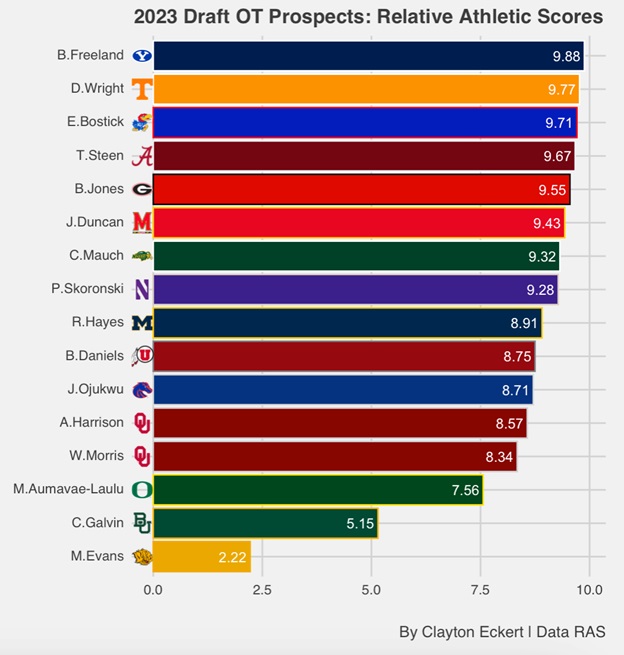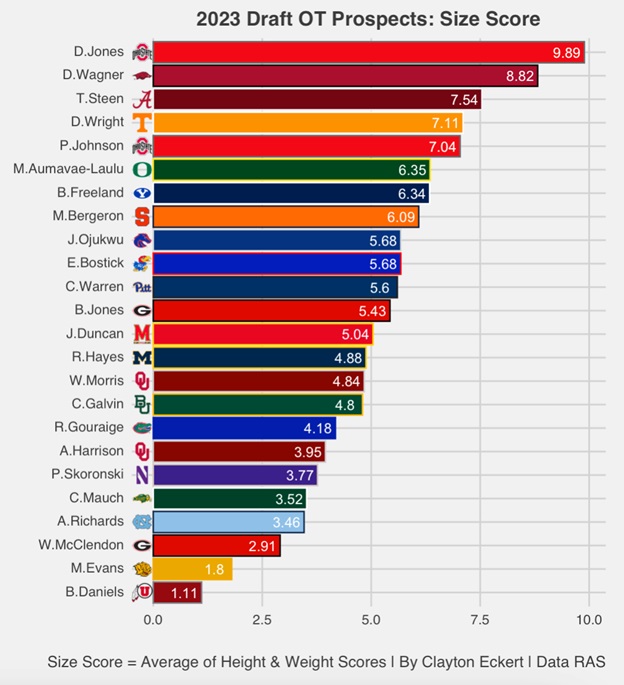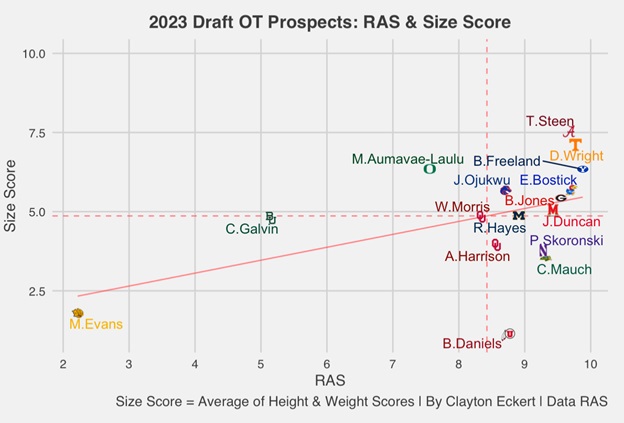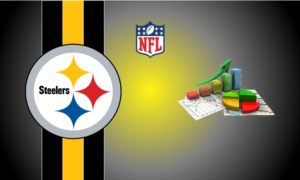Today I wanted to analyze some great data from Kent Lee Platt’s Relative Athletic Scores (RAS) for the offensive tackles. Here is a link to Platt’s website in case you haven’t seen his work https://ras.football/. To qualify for a RAS score, a player must have a total of six recorded metrics from any of the following: Height, Weight, Forty-yard dash, Twenty-yard split, Ten-yard split, Bench Press, Vertical Jump, Broad Jump, Short Shuttle, and 3-Cone. The player is then graded on each in comparison to the positional database since 1987 to get more of a feel of their size, speed, explosion, agility, and total value, giving context to the raw numbers.
The goal of the series is to provide the RAS from Platt, with a bit of my own twist with a size score and visualize it to get a simultaneous view of all the players at their position that participated at the combine. Here are the players that qualified for a RAS (NOTE: Positions are grouped from the Combine results tracker compiled by Dave Bryan and Alex Kozora):
The position fares very well athletically, highlighted by exactly half of the 16 qualifying prospects having a RAS of nine of above. BYU’s Blake Freeland (9.88 RAS) has elite speed and explosion, good size and agility, with a historically elite 37” vertical his best mark and weighing 302 pound his lowest metric. Tennessee’s Darnell Wright (9.77 RAS) has elite speed, great explosion, good size, but didn’t do agility testing, with a 907 broad jump his best mark and height (6053) his lowest mark. Earl Bostick of Kansas (9.71 RAS) has elite speed, great explosion, okay size, but no agility testing, posting a 1.68 10-yard split as his best workout and weighing 309 his lowest mark in the RAS database. Alabama’s Tyler Steen (9.67 RAS) has good size and explosion, but didn’t qualify in agility and no speed drills, with 31 reps on the bench his best number and standing at 6’6” his lowest mark.
Georgia’s Broderick Jones (9.55 RAS) has elite speed, good explosion, okay agility, but no agility testing, with a historically strong 1.67 10-yard split his best mark and height his lowest (6053). Maryland’s Jaelyn Duncan (9.43 RAS) has elite explosion, great speed, okay size, but no agility testing, with his 905 broad jump his best number and weighing 306 his lowest mark. Cody Mauch of North Dakota State (9.32 RAS) has elite agility, great speed, good explosion, but poor size, with a strong 7.33 three cone his best drill and weighing 302 pounds the lowest mark. Northwestern’s Peter Skoronski (9.28 RAS) has elite explosion, great speed, but poor size and didn’t qualify in agility, with his 34.5” vertical his best number and standing 6’4” his lowest mark, a totally acceptable mark which emphasizes solid workouts for him and the previously mentioned players overall.
Five players had RAS scores in the eight range (13/16 have an RAS above eight), starting with Michigan’s Ryan Hayes (8.91) who has great speed and agility, good explosion, okay size, with his unofficial 7.39 three cone his best drill, but weighing 298 pounds his low mark. Utah’s Braeden Daniels (8.75 RAS) has elite speed, great explosion and agility, but very poor size, posting a strong 1.7 10-yard split and height (6035) his lowest mark. Boise State’s John Ojukwu (8.71 RAS) had nice numbers across the board with great agility, good speed and explosion, okay size, with his 4.52 shuttle his best workout and weighing 309 pounds his lowest in the RAS database.
Oklahoma’s Anton Harrison (8.57 RAS) has elite speed, good explosion, but poor size and no agility testing, with his 2.87 20-yard split his best and height (6043) his lowest yet acceptable result. Oklahoma teammate Wayna Morris (8.34 RAS) has good speed and explosion, okay size, but no agility testing, with his 903 broad jump his best mark and weighing 307 his lowest.
Oregon’s Malaesala Aumavae-Laulu is the only prospect with a RAS in the sevens (7.56), and has good size, speed, explosion, and agility, with his 1.73 10-yard split his best mark and 18 reps on the bench his lowest.
After a drop off with no prospects in the six range, we see Baylor’s Connor Galvin with the second lowest 5.15 RAS, who has good explosion, okay size and speed, but poor agility, with 29 reps on the bench his strongest workout and weighing light at 293 pounds his lowest mark.
After another big drop off we see the final player in Mark Evans of Arkansas Pine-Bluff (2.22 RAS) who has okay speed, poor explosion and agility, and very poor size, with a 7.75 three cone as his best number, and historically low height (6024) for the position his lowest mark, and an arm length of 32.375 being shorter than what Pittsburgh has typically looked for.
Next, I wanted to provide more context with a size score using the RAS for the players height and weight, which includes all the combine invites since all the players are measured:
Overall, there is less size at the position in this year’s draft than 2022, when three prospects had a RAS above nine compared to just one in 2023. This mountain of a man is Ohio State’s Dawand Jones (6082, 374) which are both elite, particularly the latter, but didn’t qualify for an RAS with no explosion of agility testing, and posted poor speed with a 1.92 10-yard split his lowest mark that is barely outside of Pittsburgh’s draft history.
Dalton Wagner of Arkansas is the only prospect in the eight range (6080, 320) which is great size, but poor explosion including his lowest mark (24.5” vertical) with no speed or agility testing that kept him from qualifying for a RAS.
Three players have size scores in the seven range (which is a good RAS rank), including Steen (6060, 321) along with his strong 9.67 RAS, Wright (6053, 333) who had the second ranked 9.77 RAS, and Ohio State’s Paris Johnson (6063, 313) who didn’t qualify for an RAS, but paired his size with 29 reps on the bench and a 902 broad jump.
In the six range, there are three prospects. Aumavae-Laulu (6054, 317) begins this tier, and important to recall his good overall testing but 18 reps on the bench just outside of what Pittsburgh has typically drafted at the position. Freeland (6077, 302) pairs this with the top ranked RAS, and safe to expect that he could bulk up for a team due to his height. Syracuse’s Matthew Bergeron (6052, 318) didn’t test fully, pairing his size with good explosion testing with a 30.5 vertical and 807 broad jump.
Five prospects land in the five range of size scores, including Ojukwu (6056, 309) along with solid and complete testing, Bostick (6056, 309) who has the third ranked 9.71 RAS, Pittsburgh’s Carter Warren (6054, 311) who didn’t do any athletic testing, Broderick Jones (6053, 311) along with his 9.55 RAS, and Duncan (6055, 306) who also had a strong 9.43 RAS.
Four players have size scores in the four range: Hayes (6063, 298) who could and will likely need to bulk up, Morris (6053, 307), Galvin (6065, 293) with the latter being lighter than Pittsburgh’s draft history and important to recall his second lowest 5.15 RAS, and Florida’s Richard Gouraige (6050, 306) who didn’t test other than measurables.
Another four players have scores in the three tier: Harrison (6043, 312), Skoronski (6040, 313) with a 9.28 RAS, Mauch (6050, 302) with a 9.32 RAS, and North Carolina’s Asim Richards (6042, 309) who didn’t participate in athletic testing.
Georgia’s Warren McClendon (6041, 306) is the only player with a size score in the twos (2.91), and had 20 reps on the bench but no athletic testing.
Two prospects had low size scores in the one range, starting with Evans (6024, 303) though it still meets the low bar of Pittsburgh’s draft history, but important to recall his arm length would set a new precedent. The final player is Daniels (6035, 294) with the latter on the cusp of Pittsburgh’s past thresholds, but did pair this with elite and great athletic testing.
To wrap up, here is a visual layering the RAS and size score to take it all in:
There is clearly a lack of prospects at the extreme upper right of the chart. Dawand Jones and Wagner topped the size scores but aren’t pictured due to a lack of testing, but are very notable for the types of players and offensive line Pittsburgh has started building in free agency for the 2023 season. Of the qualifying prospects, Steen and Wright have the best balance of both with above nine RAS and seven size scores. Freeland stands alone in the next tier with an above nine RAS and a size score in the sixes. Bostick and Broderick Jones also have RAS’s above nine and pair this with above the mean size scores. Two other players that are and clearly above the mean in both are Ojukwu and Duncan. Skoronski and Mauch highlight the group on the bottom right with great athleticism but lack size comparatively, not concerning considering if Pittsburgh’s draft history, and if that holds true only two player would barely miss their weight thresholds (Galvin and Daniels).
For those that like the numbers, it’s unfortunate a few players didn’t test fully, and it will be interesting to monitor the pro days and continue to see how the men stack up in the coming weeks when Platt updates the site with the unofficial numbers.
What are your thoughts on the data? Thanks for reading and let me know your thoughts in the comments.










